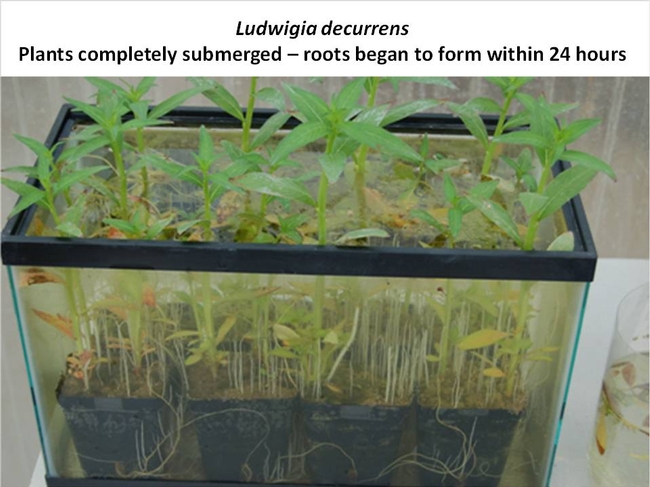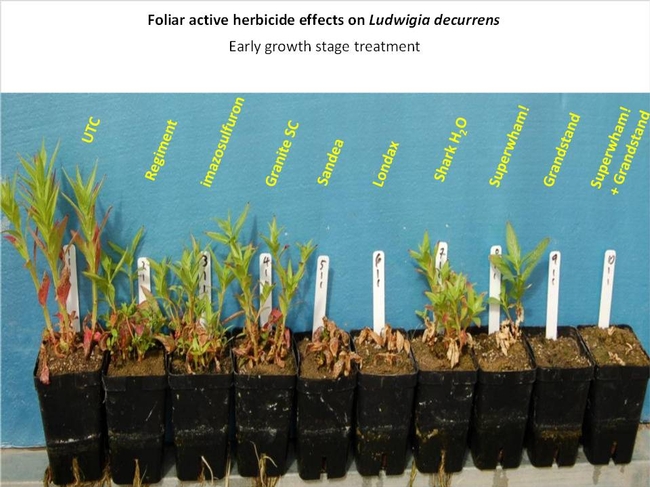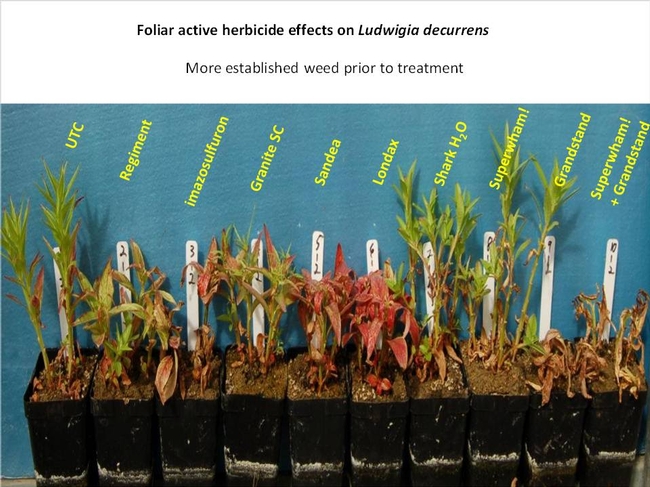Summary
Winged primrose willow is an invasive weed that was identified in Butte County rice fields in 2011. Most infestations were along borders of fields and canals; however, this weed can thrive in the flooded environment within rice fields. Winged primrose willow can disperse through seeds and plant fragments floating in the irrigation water and tillage and harvest equipment.
Greenhouse tests showed that winged primrose willow can be controlled with rice herbicides. Early, into-the-water applications of Bolero Ultramax, Cerano or Granite GR effectively killed young plants. Foliar applications of Sandea and Londax were effective in controlling young plants (1.5 inches). Older plants (2.5 inches) were controlled by Grandstand or a tank mix of Grandstand and SuperWham.
After the initial discovery of winged primrose willow (Ludwigia decurrens) in Butte county, it was determined by Farm Advisors and the Agricultural Commissioner that the infestation expands over several square miles. Most infestations are along borders of fields and irrigation canals. One field had an infestation throughout. It is likely that this weed has gone undetected for up to five years or more. Seed capsules from this plant have thousands of seeds which are capable of floating on the water surface as a means of dispersal, especially along irrigation canals. Indeed, the Butte County Agricultural Commissioner believes this has been the main means of dispersal across the majority of the infested area. Other potential means of spread are by tillage equipment and combines. Additionally, it has been determined that plant fragments have the ability to grow roots within a day or two when in water. This suggests that mowing of levees as a means of control may potentially increase dispersal of this weed.
Testing in the greenhouse at the Rice Experiment Station indicates that the plant germinates best when the soil is moist but not flooded. However, the seed can germinate under water and eventually grow above the water surface with the potential to survive in a rice field and set seed. This plant also has the ability to form roots that grow upwards through the water column in order to scavenge oxygen near the water surface. Glyphosate will control this plant on levees, but any formed seed capsules will have viable seeds that will likely germinate the next season if not removed from the field and buried in a landfill as requested by the Agricultural Commissioner. It is suggested that any levee spraying of known infestations happen early in the season prior to the yellow flowers being visible.
Testing of currently available rice herbicides indicates several potential options for control of this invasive weed within rice fields. We tested early season water active herbicides (Table 1). This was done at early water flood and on larger, more established weeds. The early flood treatment entailed moistened soil for 3 days prior to the flood being established. This was intended to simulate the flooding of large fields where the soil is moist as water is built up for flood. Winged primrose willow will germinate under this conditions prior to flood. Herbicide treatments were applied after the flood was established. The later timing entailed plants that were allowed to establish and grow to approximately 2.5 inches in moist soil, then the flood was established and herbicide treatments applied. This treatment method was intended to be similar to a drill seeded situation where into water herbicides could be applied after establishment of permanent flood.
Table 1. Water active herbicides tested against winged primrose willow at Biggs, CA.
In continuous flood, Cerano caused bleaching and eventual death of the small plants. The later application of Cerano slowly bleached the plants and it is believed that they will not be able to produce viable seed. Bolero Ultramax activity was fairly slow, but eventually killed both young and older plants when flood was maintained. Granite GR slowly bleached the young plants and it is expected to fully control the weed at that stage; however, more established plants survived the treatment and would likely set seed. Shark H2O initially appeared to be very efficacious on both plant sizes; however, plants were able to survive the treatment by putting on new leaves. These plants eventually flowered and would be expected to produce viable seeds. Sandea applied to the flood water did not control the weed although it caused some malformations of the typical plant. It is likely the plants surviving the Sandea treatment would set seed.
We also tested later season foliar herbicides (Table 2) on both early establishment and larger more established plants. Early establishment in this case consisted of plants allowed to establish to approximately 1.5 inches tall at time of application. The larger, more established plants were approximately 2.5 inches tall.
Table 2. Foliar active herbicides tested against winged primrose willow, Biggs, CA.
Regiment did not control either young or old plants. Granite SC also did not fully control either age of plants. Sandea and Londax, however, appear to control the weed sufficiently when it is young but less effectively when it is more established. Shark H2O initially appeared to be the best treatment with rapid severe burn of leaves, but the plants recovered by producing new leaves. These plants eventually produced flowers and would be expected to have viable seed. SuperWham provided some control when the plants were small, however the more established plants were not significantly hindered. Grandstand caused severe damage to both young and established plants. The tank mix of SuperWham and Grandstand was the most efficacious of all the foliar treatments.
Conclusions
The best control strategy for winged primrose willow in rice culture would be to use early water active herbicides like Bolero Ultramax, Cerano or Granite GR when the weed is very small and more vulnerable to treatment. If follow-up foliar herbicides are needed, early appications of Sandea or Londax may be sufficient when the weed is still very small. Later foliar applications for control of winged primrose willow would require Grandstand or a tank mix of Grandstand plus SuperWham. Some of the treatments that did not kill winged primrose willow may have been sufficient to prevent establishment in rice and setting of viable seed.






